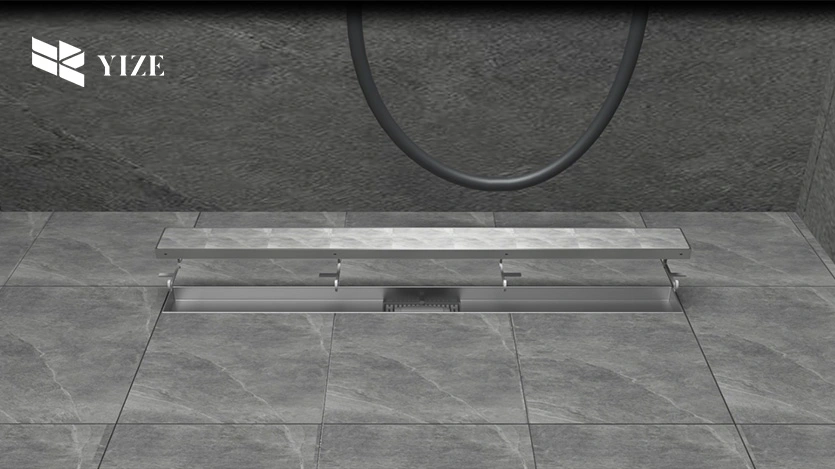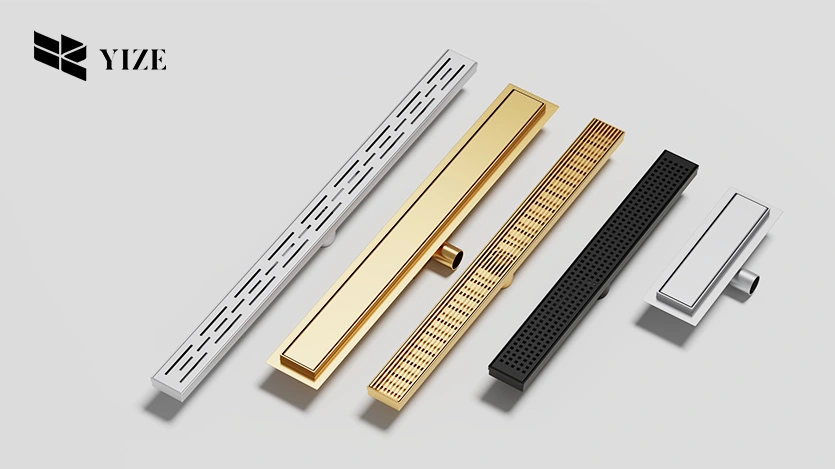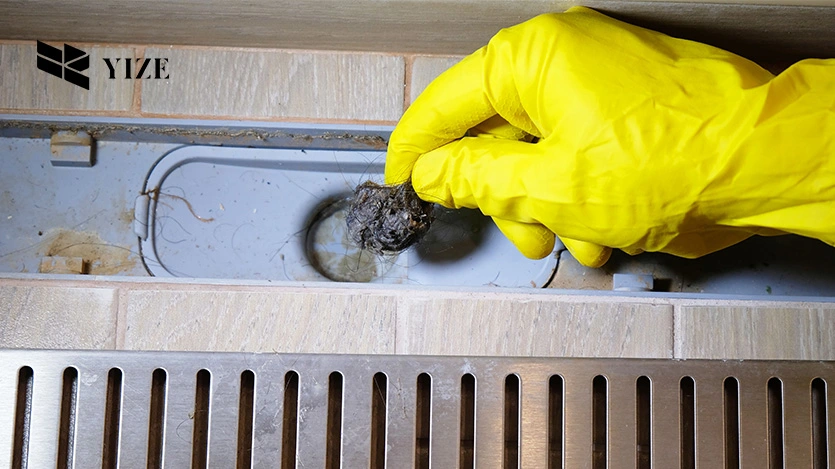
I. Introduction
Linear shower drains have become the favorite of many modern bathrooms they can provide an elegant appearance while providing benefits that may be superior to point drains. Nevertheless, the maximum benefits of linear shower drains are possible only if this product has been installed correctly.
In the event that management of these processes does not meet laid down procedures, the drain may not serve its intended purpose of draining water or may contribute to water pooling, leaks or structural deformations. In this guide, you will understand all things about linear shower drain installation and how to have both functionality and style in your bathroom.
I. Part 1: What is a Linear Shower Drain?
A linear shower drain is a long, slim shower drain that usually is installed across the entire width of your shower floor. A point drain needs the slope in four directions while the linear drain only needs it in one direction, thus requiring less efforts in terms of design and installation to achieve a clean look.
Some of the benefits of linear drains over point drains include the following The following are the benefits of linear drains over point drains. They offer a better arrangement of water to drain in a shower area, especially if the shower is a big one or a walk in shower and they also make it possible for one to use any tile they desire in the shower area since they do not have to trim tiles around a small central drain. Besides, linear drains can be also installed under the shower edge which gives the shower a sleek non-invasive appearance.
III. Part 2: How to Install a Linear Shower Drain?
A linear shower drain is installed in a specific manner and a certain pattern has to be followed while installing it. In this section, you will find one-stop information to assist you properly install your linear shower drain.
1. Preparation
Ensure that you have all necessary equipment and supplies as some drains may be larger than others, connectors, and glue. Preparation is crucial prior to the installation process in order to avoid problems during the process.
2. Installation : 5 Simple Steps
●Planning and Measuring: Choose the location that will be suitable for the drain and then take your measurements. Place a sign on the spot while making sure that it is in line with the plumbing.
●Cutting the Floor: As indicated on the shower base plan, saw through the floor in order to make a hole for the drain to fit. This can be done by using the correct type of saw that corresponds to the type of floor material that is being cut.
●Connecting the Drain: Place the drain in the slot and secure it to the waste outlet. Make sure all contacts are tidy and airtight to avoid damage from water.
●Securing the Drain: Secure the drain and ensure it is firmly anchored and leveled to the bottom of the boat. This step helps to avoid troubles in the future such as shifting.
●Finishing Touches: Leave the drain cover, apply the sealant where it joints the floor, and correct the floor slant if necessary. Flush the drain with water to confirm that the sinkage is effective in its function.
IV. Part 3: What’s the Right Size for Your Shower Drain?

When selecting the linear shower drain size, it is essential to consider the requirements of the drain and its compatibility with the surroundings. The diameter of your shower drain opening should be proportional to the size of your shower space and the ability of the pipes to drain the shower.
1. What are Typical Shower Drain Dimensions?
There are different types of linear shower drains, and these are available in a number of sizes, with lengths stretching from 24 inches to 60 inches. When it comes to the size of the shower, it can be determined based on its general width and the location of tiles. Depending on the size of the walk-in shower, more or less drain can be installed; more drain might be required for a large walk-in shower space while less drain can suffice for a small walk-in shower space. Moreover, another characteristic of the drain that one has to factor in is the width and depth of the drain in relation to water flow.
2. Factors Influencing the Choice of Size
In choosing the size of a drain, the slope of the shower bottom, the size of the tiles to be used, and the anticipated water flow rate are important factors that should be taken into consideration. Moreso, having a well-sized drain will ensure that water does not accumulate or take long to drain hence improved functionality of the shower as well as improved aesthetics.
V. Part 4: Measuring Shower Drain Size
When you want to install your shower drain, it is important that you get the drain size right every time. Here’s how you can do it:Here’s how you can do it:
1. How to Measure Shower Drain Size?
First, it is required to measure the area where the drain will be placed, choosing the desirable length and width. Measuring the object under consideration should be done with the help of a tape measure, and each of the obtained dimensions should be written down. Next, check the height or depth of the shower floor to ensure the position of the drain that should be snug or slightly shallower than should be flush with the surface.
2. Equipment Needed for Measurement
In order to properly determine the size of a shower drain, the following tools should be used: a measuring tape, a ruler as well as a level in some cases. These tools will aid you in making certain that your measurements are correct and that your drain will fit well.
3. Measures to Follow to Avoid Wrong Measurements
Make sure that you are accurate with the size of the drain before going out to buy one to prevent the embarrassment of having to return later. When taking measurements it should be noted that the floor slope and thickness of tiles will also have an influence on the final position of the drain.
VI. Part 5: Identifying and Solving Common Issues
Now, let me discuss some of the problems you may face even with the correct installation of the linear shower drain. Here’s how to identify and solve them:Here’s how to identify and solve them:
1. Why is My Shower Drain So Loud?
A consistent shower drain noise may be attributed to issues with installation, trapped air, or the debris in the drain. To check if noise is minimized or eliminated ,one should check installation to see that the drain is well fixed and connected. Regular cleaning of the drain can also reduce noise due to blockages in this pipe.
2. Caring for Your Linear Shower Drain
Cleaning your linear shower drain regularly is vital in maintaining its effectiveness. Another precaution is clearing the drain cover of debris and cleaning it at a regular basis in order to avoid blockages. Furthermore, a weak detergent solution should be used for the internal cleaning of the drain to counter the formation of both soap residue and mineral deposits.
3. Preventive Measures to Avoid Clogs and Noise Issues
There are many solutions that can help to solve these problems, one of them is to use a drain protector to prevent hair and other waste items from going down the drain and making noise. Maintenance is important here, including cleaning and inspecting the drain, which will ensure the part is in proper working order.
VI. Part 6: How Often Should You Clean a Linear Shower Drain?

This means you should clean the linear shower drain at least once a month to make sure it remains effective. Cleaning frequency eliminates the accumulation of dirt hence avoiding formation of blockages and noises.
VII. Part 7: Why Choose YZDRAIN for Your Linear Shower Drain Needs?
In this case, it is clear that the linear shower drain that can be recommended is YZDRAIN. YZDRAIN products are built to be sturdy, practical and aesthetically pleasing. They are made of durable material and come in different shapes and colors to suit any bathroom dcor. YZDRAIN linear shower drains has anti-noise technology to help make your shower time as quiet as you want it to be. Furthermore, their installation guide is quite easy and does not require professional help from technicians.
vIII. Conclusion
A professionally installed linear shower drain is not only functional in the bathroom but also an aesthetic addition. So, by following the above-stated installation procedures and selecting the suitable size and brand such as YZDRAIN, the shower drain would work optimally in the long run. The simple routine of cleaning and maintenance will ensure that your drain remains in good condition to offer you a stylish and efficient drain in your bathroom.
FAQs
1. What is a linear shower drain?
A linear shower drain is a straight and narrow drain that has been specifically designed for showering applications. It has a more contemporary appearance to it and is less complex when installing with big tiles.
2. What factors should I consider when selecting the size of my linear shower drain?
Select the right size of the drain depending on the size of the shower and the flow rate of water. Some of the factors to consider when choosing the size include the slant of the floor and the sizes of the tiles.
3. How frequently should I clean my linear shower drain?
In terms of maintenance, it is advisable to clean the linear shower drain on a monthly basis to eliminate blockages on the surface.
